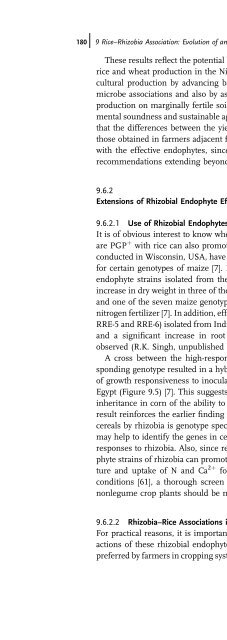Page 2 Plant-Bacteria Interactions Edited by Iqbal Ahmad, John ...
Page 2 Plant-Bacteria Interactions Edited by Iqbal Ahmad, John ...
Page 2 Plant-Bacteria Interactions Edited by Iqbal Ahmad, John ...
Create successful ePaper yourself
Turn your PDF publications into a flip-book with our unique Google optimized e-Paper software.
180j 9 Rice–Rhizobia Association: Evolution of an Alternate Niche<br />
These results reflect the potential benefits of rhizobial biofertilizer inoculants for<br />
rice and wheat production in the Nile delta. This knowledge should improve agricultural<br />
production <strong>by</strong> advancing basic scientific knowledge on beneficial plant–<br />
microbe associations and also <strong>by</strong> assisting low-income farmers to increase cereal<br />
production on marginally fertile soils using biofertilizers consistent with environmental<br />
soundness and sustainable agriculture. In this regard, it must be considered<br />
that the differences between the yields of the best experimental treatment(s) and<br />
those obtained in farmers adjacent fields cannot be solely attributed to inoculation<br />
with the effective endophytes, since they include the whole research package of<br />
recommendations extending beyond inoculation.<br />
9.6.2<br />
Extensions of Rhizobial Endophyte Effects<br />
9.6.2.1 Use of Rhizobial Endophytes from Rice with Certain Maize Genotypes<br />
It is of obvious interest to know whether superior rhizobial endophyte strains that<br />
are PGP þ with rice can also promote the growth of other cereal crops. Field tests<br />
conducted in Wisconsin, USA, have provided preliminary evidence for this, at least<br />
for certain genotypes of maize [7]. In that study, inoculation with one of the rice<br />
endophyte strains isolated from the Nile delta resulted in statistically significant<br />
increase in dry weight in three of the six tested maize genotypes in the greenhouse<br />
and one of the seven maize genotypes in experimental field plots that received no<br />
nitrogen fertilizer [7]. In addition, effects of rice rhizobial endophytic strains (RRE-2,<br />
RRE-5 and RRE-6) isolated from India [30] were also tested on some maize cultivars<br />
and a significant increase in root proliferation and overall plant growth were<br />
observed (R.K. Singh, unpublished data).<br />
A cross between the high-responding maize genotype and a different nonresponding<br />
genotype resulted in a hybrid maize genotype with an intermediate level<br />
of growth responsiveness to inoculation with the rhizobial endophyte strain from<br />
Egypt (Figure 9.5) [7]. This suggests the possibility of genetic transmissibility and<br />
inheritance in corn of the ability to respond to selected endophytic rhizobia. This<br />
result reinforces the earlier finding that induction of positive growth responses in<br />
cereals <strong>by</strong> rhizobia is genotype specific (also in maize). Such experimental results<br />
may help to identify the genes in cereals necessary for expression of these growth<br />
responses to rhizobia. Also, since recent work indicates that one of our rice endophyte<br />
strains of rhizobia can promote the growth of shoots and roots, root architecture<br />
and uptake of N and Ca 2þ for certain cotton varieties under growth-room<br />
conditions [61], a thorough screen of their potential benefit to a wide variety of<br />
nonlegume crop plants should be made.<br />
9.6.2.2 Rhizobia–Rice Associations in Different Rice Varieties<br />
For practical reasons, it is important to know whether the various desirable interactions<br />
of these rhizobial endophytes can be extended to cereal varieties that are<br />
preferred <strong>by</strong> farmers in cropping systems worldwide. The number of varieties tested
















